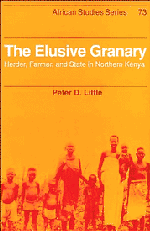Book contents
- Frontmatter
- Contents
- List of illustrations
- List of tables
- Preface
- 1 Introduction: the study of agrarian change among African herders
- 2 Society, ecology, and history
- 3 Markets and the state
- 4 Labor and agropastoral production
- 5 Income, wages, and investment
- 6 Expenditures, consumption, and the food crisis
- 7 Land conflicts and sustainability
- 8 In pursuit of the granary: development responses of community, donor, and state
- Notes
- References
- Index
- AFRICAN STUDIES SERIES
4 - Labor and agropastoral production
Published online by Cambridge University Press: 04 August 2010
- Frontmatter
- Contents
- List of illustrations
- List of tables
- Preface
- 1 Introduction: the study of agrarian change among African herders
- 2 Society, ecology, and history
- 3 Markets and the state
- 4 Labor and agropastoral production
- 5 Income, wages, and investment
- 6 Expenditures, consumption, and the food crisis
- 7 Land conflicts and sustainability
- 8 In pursuit of the granary: development responses of community, donor, and state
- Notes
- References
- Index
- AFRICAN STUDIES SERIES
Summary
Both the colonial and independent governments imposed a regional market structure that did very little to improve or even sustain local production. Herders learned early in this century that reliance on the market, whether for sale of animals or purchase of grain, is problematic. Because of these unfavorable conditions, herders attempt to circumvent the market by producing their own grain through irrigated, and in some cases dryland, farming. This strategy spread dramatically in the 1970s and early 1980s. During the period from 1971 to 1981, irrigated agriculture in Njemps grew from approximately 106 to 266 hectares, the number of irrigation farmers increased from 106 to 377 (29 percent of total families in 1981), and the average size of farm rose from 0.56 to 0.71 hectares. Since then an additional 125 hectares have come under cultivation, with approximately 100 new herders beginning to irrigate during 1981 to 1985. Dryland agriculture, which involves up to 25 percent of herders in certain years, has expanded as well. The agricultural initiatives often have strained domestic labor supplies, heightened economic differentiation, and exceeded local organizational capacity. Thus, the results of increased diversification of the local economy have been mixed at best.
Farming is pursued today but under very different social, ecological, and economic conditions than had marked the precolonial period. Unlike cultivation in the earlier era, agriculture is currently an activity supplemental to livestock production; in this sense the II Chamus are more like cultivating herders than agropastoralists.
- Type
- Chapter
- Information
- The Elusive GranaryHerder, Farmer, and State in Northern Kenya, pp. 63 - 90Publisher: Cambridge University PressPrint publication year: 1992



